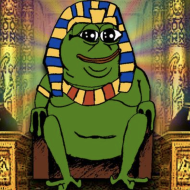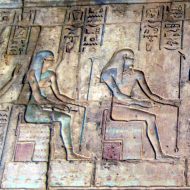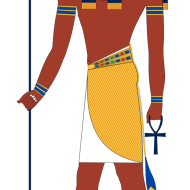Kek : The God of Darkness
Listen
At a glance
| Description | |
|---|---|
| Origin | Egyptian Mythology |
| Classification | Gods |
| Family Members | Kauket (Wife) |
| Region | Egypt |
| Associated With | Darkness, Creation |
Kek/Kauket
Introduction
The ancient Egyptians had a complex and diverse pantheon of gods and goddesses, each representing different aspects of nature, life, and the cosmos. Among them were Kek and Kauket, the deities of darkness, obscurity, and the night. They were part of the Ogdoad, a group of eight primordial gods who existed before the creation of the world.
Physical Traits
The Ogdoad were depicted as having both human and animal forms. The males had the heads of frogs, while the females had the heads of snakes. They were also associated with different directions: Nun and Naunet with west, Amun and Amaunet with north, Kek and Kauket with south, and Heh and Hauhet with east.
Family
The Ogdoad (meaning “the eightfold”) was a cosmogony that originated in the city of Hermopolis, also known as Khmunu or “the city of the eight”. According to this cosmogony, before the world was formed, there was only a dark and chaotic watery abyss called Nun. In this abyss, Kek and Kauket, the male and female aspects of darkness were created.
Ket and the Ogdoad is said to have lived in harmony in the abyss, until a lotus flower emerged from the waters and gave birth to Ra, the sun god. Ra then created the world and all living beings, while the Ogdoad retreated to the underworld, where they continued to support his creation.
Other names
The name is written as kk or kkwy with a variant of the sky hieroglyph in ligature with the staff associated with the word for “darkness” kkw.
Powers and Abilities
Kek represents the lack of knowledge, light, and visibility. They also represent the chaotic and unknown elements of our existence that preceded harmony and order. Kauket’s name is a feminine form of Kek, while the name of the Kek means darkness. The term “raising up of the light” and “raising up of the night” refer to their function in guiding Ra throughout his daily cycle.
The Kek was the god who ushered Ra’s solar vessel into the sky during the hours before dawn, as darkness rose. Likewise, the goddess Kauket was the one who brought the evening to life as darkness fell. Both the Kek and Kauket were associated with twilight, which occurs when the opposing forces of darkness and light mingle. They can mediate conflict between life, death, chaos, and order.
Modern Day Influence
The Kek and Kauket were linked to twilight, which occurs when the light and the darkness interact. They can be described as mediators between opposing forces, such chaos, death, and order. Although they weren’t worshipped in Egypt, Kauket and Kek were regarded as significant deities in the cosmic balance. The two were often invoked in rituals and spells to protect themselves from evil forces or to obtain knowledge.
The term Kek has become a meme that’s associated with online subcultures. It stems from the alternative spelling of “lol,” which is also used in games. It’s related to the frog-like image of “Pepe,” which has been used as a symbol by different groups online. Some people think that Kek is a god who can affect events through memes.
Related Images
Frequently Asked Questions
What is lorem Ipsum?
I am text block. Click edit button to change this text. Lorem ipsum dolor sit amet, consectetur adipiscing elit. Ut elit tellus, luctus nec ullamcorper mattis, pulvinar dapibus leo.
What is lorem Ipsum?
I am text block. Click edit button to change this text. Lorem ipsum dolor sit amet, consectetur adipiscing elit. Ut elit tellus, luctus nec ullamcorper mattis, pulvinar dapibus leo.
What is lorem Ipsum?
I am text block. Click edit button to change this text. Lorem ipsum dolor sit amet, consectetur adipiscing elit. Ut elit tellus, luctus nec ullamcorper mattis, pulvinar dapibus leo.
What is lorem Ipsum?
I am text block. Click edit button to change this text. Lorem ipsum dolor sit amet, consectetur adipiscing elit. Ut elit tellus, luctus nec ullamcorper mattis, pulvinar dapibus leo.
What is lorem Ipsum?
I am text block. Click edit button to change this text. Lorem ipsum dolor sit amet, consectetur adipiscing elit. Ut elit tellus, luctus nec ullamcorper mattis, pulvinar dapibus leo.










